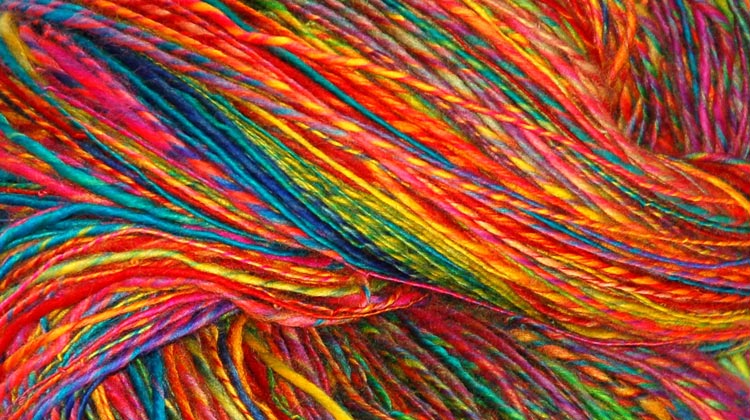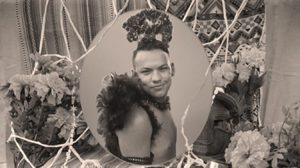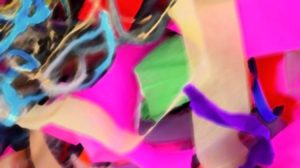
SIZE: One size, made to drape over the shoulders of any body.
MATERIALS: First, find a brightly colored yarn, as close to an actual rainbow as you can find.
Then, find a contrasting yarn that’s as fluffy as a cloud. I recommend a color from your favorite pride flag, but it can be whatever color you desire.
GAUGE: Is not important. But do not knit tightly and tire your hands. Because being kind to your body is a revolutionary act.
KEY: A key is a collection of meanings & symbols. A key is the object that allows you to turn the lock of a rusted gate, find your way across imaged distances on a map, or enter into a vibrant community.
REMEMBER, once you were new to this place and did not understand every word that was uttered. Once, you thought you were having a conversation with someone, but later you realized that although you used the same words you were talking about two different things.
A shared vocabulary is the thing that allows us to share stories, ideas, knowledge.
k: knit
p: purl
RS: right side
WS: wrong side
YO: yarn over
TO BEGIN: Create a garter stitch tab. We will do this by casting on three stitches, knitting six rows, and then picking up and knitting three stitches on two sides of the tab. There will be nine stitches on your needles when you are done.
BEGINNINGS are hard, and beginnings are formative.1 When knitting they can be fiddly things. Your stitches fall off your needles, your nimble fingers suddenly feel awkward and too large. Always continue.
When you gather with other knitters, much like when you gather with other queer folks, the subject of beginnings inevitably comes up. You cement a friendship by learning each other’s individual genesis. “How did you learn how to knit?” From your mother, or your grandmother, or from a book. Matrilineal inheritances are praised; the absence of them is mourned.
Once a straight friend introduced me to another of her friends. Over our first sips of beer, he asked me, “How old were you when you came out?” We swapped stories. My straight friend was enthralled.
“I could never ask you that! Like that!”
“No.”
“But he could ask you that!”
“Yes.”
WORK THE SHAWL: We build community one stitch at a time. Although the work may feel endless, somehow we make a fabric.
Row 1 (WS): K3, YO, P to 3 sts from end, YO, K3.
Row 2 (RS): K3, YO, K1, PM, K to 3 sts from end, YO, K3.
Row 3, and all odd rows: As row 1.
Row 4: K3, YO, K3, P to marker, K1,* K3 P1 to 3 sts from end, YO, K3.
Row 6: K
Row 8: K3, YO, K3, P to marker, *K1, P1, K2 to 3 sts from end, YO, K3.
MAKING A FABRIC: When sewing a garment, you take fabric that is already woven and cut it into shape. When knitting, you make the fabric at the same time you make the garment itself. We talk of “knitting a sweater,” but really what we do is make fabric, stitch by stitch, that is conveniently already formed into the shape of something we can wear.
Women’s work is easy to look down upon, even among women, and it is easy to overlook. So easy that it has served as a cover for insidious queer and feminist gatherings of yore; there was the lesbian and bisexual “sewing circle” of Hollywood,1 and the feminist Knitting Circle in London, of which lesbian writer Radclyffe Hall was a member.3 Craft was poised, then, for reclaiming by the second wave feminists of the 70s, ready to shift from the disquiet shadows of domestic un-bliss to the hands of radical thinkers and activists.3 And still, the act of making became the making of community.
Once, when I was living in London and knew only a handful of people – all of them other Americans – I decided to go, alone, to a queer knitting group held at a gay bar near the Thames. The details are vague in my mind, and although I don’t remember what project I was working on that day, I do remember leaving the group slightly drunk on Pimm’s, entering into the city sun from the dark bar, turning down a street of cobblestones and awed by the human ability to feel briefly, but deeply, connected to people I would never see again.5
Repeat until your shawl measures nearly the desired width and length.
CONTRAST ROWS:
Now we will add in our second yarn.
Row 1 (WS): With contrast yarn, K3, YO, K to 3 sts from end, YO, K3.
Row 2 (RS): With contrast yarn, K3, YO, K to 3 sts from end, YO, K3.
Row 3: With main yarn, K3, YO, P to 3 sts from end, YO, K3.
Row 4: With main yarn, K3, YO, K to 3 sts from end, YO, K3.
MIX METAPHORS: Our language is rife with metaphors that come from making things by hand. Our communities are “tightly knit”; when we tell stories we “spin a yarn.” Once, “wool gathering” was a thing shepherds did as they tended their flock, plucking wool from branches—knitting as they watched their sheep.6
Wool holds together in the shape of yarn because it holds tension within itself, like a spring. This is a metaphor for our own internal turmoil, the human conflict we keep within ourselves, twisting and untangling our own contradictions. Eventually we work through the internalized homophobia and transphobia but the traces of it remain within us, holding us together.
Repeat these 4 rows six times. Work Row 3 once more.
HOLD SPACE: A yarn over, in knitting, is the intentional creation of absence. It is the knitting equivalent of onomatopoeia: you bring the yarn over the needle, which looks a bit like the dip of a Y. Once that yarn has been knit on the next row, it forms a O. YO. Doing so unintentionally is one of the most common mistakes new knitters make. Like most knitting mistakes, from dropped stitches to twisted stitches, there is a time and place when they become tools.
In knitting lace, intentional absences can create a pattern that is mystifyingly, mindbogglingly intricate. As a metaphor, it suggests that something beautiful comes out of absence, and perhaps this is where the metaphor goes too far.
LACE BORDER:
Row 1 (RS): With main yarn once again, knit across.
Row 2: K3, P to 3 sts from end, K3.
Row 3: K3, *(k2tog) 3 times, (yo, k1) 6 times, (k2tog) 3 times; repeat from * to 3 sts from end, K3.
Row 4: As row 1.
Repeat these four rows a total of eight times.
ABSENCE: What do we mean when we talk of holding space? We must work in order to remember where things are not. We remember queer lives lived in silence; we remember those killed for being gay, or queer, or trans. We march in the streets to avow that black trans lives matter.
There are smaller, less violent absences as well. As I began to write this piece, I noticed how many books on the
history of knitting (few as they are) included no mention of queer or feminist practices. There are stories to fill into these absences, but in the meantime, we must create a place for them to fit in later.
FINISH: Bind off all stitches. Weave in the ends. Block as desired. Wear your shawl to a Pride parade. Wear it to keep warm. Give it to a friend, and explain the meaning of each and every stitch.
1 The book In the Beginning by Chaim Potok begins with some of the most perfect first paragraphs I’ve ever read: “Especially a beginning that you make by yourself. That’s the hardest beginning of all.”
2 Axel Madsen’s book “The Sewing Circle” is described by Kirkus reviews as a “trashy, scandal-mongering history of lesbian and bisexual women.”
https://www.kirkusreviews.com/book-reviews/a/axel-madsen-4/the-sewing-circle-hollywoods-greatest-secret-fe/
3 If you Google this, as I did, nearly every mention on the internet circles back to the same collection of dead links. See the later section of this pattern, “ABSENCE.”
4 Lucy Lippard wrote, in 1978, that women were finding “an art that there is some excuse for making, an art that costs little or nothing and performs an ostensibly useful function into the bargain — the art of making something out of nothing.” https://monoskop.org/images/8/88/Lippard_Lucy_Get_the_Message_A_Decade_Of_Art_For_Social_Change.pdf
5 On the American side of the pond, such gatherings occur too; Britta Lokting wrote a lovely piece about gay men knittitng in dark bars for the New York TImes for Pride last year: https://www.nytimes.com/2019/06/07/nyregion/knitting-gay-men.html. It includes my favorite NYT correction to date, the exact word of which I have said in exasperation many times: “It was knitted, not crocheted.”
6 Mary Thomas’s eponymous Knitting Book describes these wool-gathering shepherds, who watched their flocks on stilts.




Ollie says
I would really love to see a pic of this shawl!! Awesome thought provoking article! Thank you!
Susan says
Just brilliant. Thank you for writing this.
Jenn says
This is one of the most beautiful pieces I have ever read about knitting and community. Thank you.